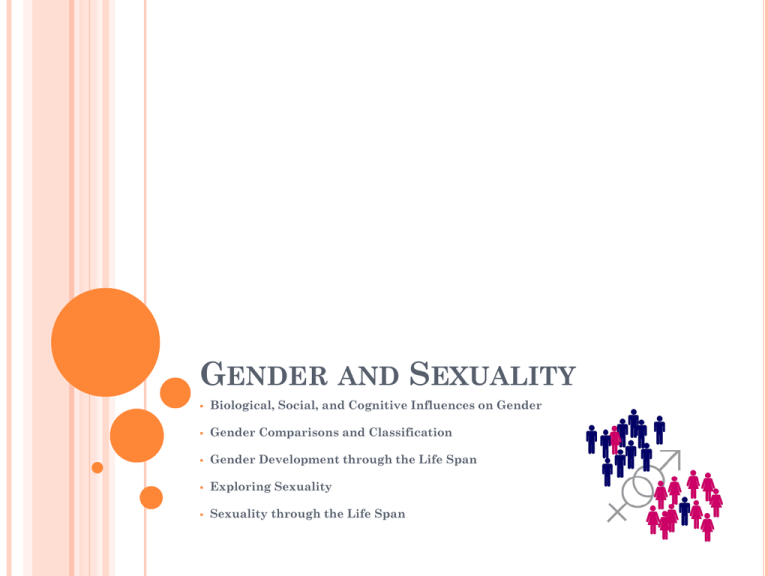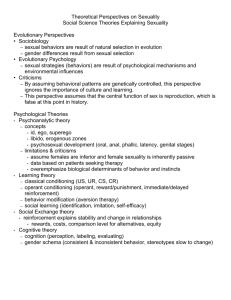
GENDER AND SEXUALITY
Biological, Social, and Cognitive Influences on Gender
Gender Comparisons and Classification
Gender Development through the Life Span
Exploring Sexuality
Sexuality through the Life Span
Biological, Social, and Cognitive Influences on Gender
GENDER AND SEX
Gender- Characteristics of being female or male.
Gender role: set of expectations prescribing how
females and males should act, feel, and think.
Gender typing: process by which children acquire
thoughts, behaviors, and feelings culturally appropriate
for their gender.
Sex- Designates the biological aspects of being female or
male.
Biological, Social, and Cognitive Influences on Gender
BIOLOGICAL INFLUENCES
Chromosomes — 23rd pair with X and Y
Hormones:
Estrogens
Influences development of female physical sex characteristics and
helps regulate menstrual cycle
Androgens
Testosterone promotes development of male genitals and secondary
sex characteristics
Examples of conditions from unusual levels of sex hormones early in
development:
Congenital adrenal hyperplasia (CAH)
Androgen-insensitive males
Pelvic field defect
Failed sex reassignment
Biological, Social, and Cognitive Influences on Gender
EVOLUTIONARY PSYCHOLOGY
VIEW OF GENDER
Differing roles in reproduction placed different pressures on
males and females
Key gender differences in sexual attitudes and sexual
behaviors
Males — competition, violence, risk-taking
Females — parenting effort, selection of successful mate
Biological, Social, and Cognitive Influences on Gender
SOCIAL INFLUENCES
Differences due to social experiences:
Social role theory: gender differences result from contrasting roles of
men and women
Psychoanalytic theory of gender: claims child identifies with samesex parent by age 5 or 6
Many disagree, claiming gender learned much earlier (even in
absence of same-sex parent)
Social cognitive theory of gender: gender development results from
observation and imitation, use of rewards and punishments for genderappropriate behaviors
Mothers’ socialization strategies
Fathers’ socialization strategies
Biological, Social, and Cognitive Influences on Gender
COGNITIVE INFLUENCES
Cognitive development theory of gender:
Children’s gender typing occurs after they think of themselves
as boys and girls; gender constancy must be achieved first.
Once consistently conceived as male or female, children prefer
activities, objects, and attitudes consistent with this label.
Gender schema theory:
Gender typing emerges gradually in gender schemas of what
is culturally gender-appropriate and inappropriate
Gender-typed behavior can occur before children develop
gender constancy
Schema: cognitive structure
Gender schema: organizes world in terms of male and female
Gender Comparisons and Classification
GENDER STEREOTYPING
Broad categories that reflect our impressions and beliefs
about females and males:
Traditional masculinity and femininity
Males – instrumental traits
Females - expressive traits
Roles and traits – unequal social status, power
Stereotyping varies with culture
Stereotyping of occupations
Gender Comparisons and Classification
Young Children’s Judgments about
Competency in Stereotyped Occupations
Gender Comparisons and Classification
GENDER SIMILARITIES AND DIFFERENCES
Physical differences:
Females
have longer life expectancy
less likely to develop mental or physical disorders
Resistant to infections, more elastic blood vessels
Female brains are smaller, have more folds.
Areas of brain involved in emotional expression show more
activity in females.
Males
Higher levels of stress hormones causing faster clotting and
higher blood pressure.
Sexually Dimorphic Nucleus is larger in men.
Area of parietal lobe functioning in visuospatial skills is larger in
males
Gender Comparisons and Classification
COGNITIVE SIMILARITIES AND DIFFERENCES
National standardized tests
Boys slightly better at math and science
Girls better at reading and writing
Overall, girls superior students to boys
Gender Comparisons and Classification
SOCIOEMOTIONAL SIMILARITIES
AND DIFFERENCES
Aggression:
Males more physically aggressive in all cultures
Females more verbally aggressive; use relational aggression
more than men
Self-Regulation:
Males show less self-regulation, can lead to behavioral problems
Controversies over psychological differences
Overall meta analysis:
Gender differences: small to nonexistent
Physical aggression differences were moderate
Largest difference in motor skills favoring males
Males more sexually active than females
Gender Comparisons and Classification
SOCIOEMOTIONAL SIMILARITIES
AND DIFFERENCES
Gender in context:
Gender varies across contexts
Males more likely to help in perceived danger
Females more likely to volunteer to help with child
Girls show more care-giving behaviors than boys
Males more likely to show anger towards strangers and turn
anger into aggression
Cultural backgrounds influence socialization
Gender Comparisons and Classification
MASCULINITY, FEMININITY, AND ANDROGYNY
Androgyny — presence of masculine and feminine characteristics
in same individual
Bem Sex-Role Inventory:
Instrumental, expressive traits
Context influencing gender role is adaptive
Gender-role transcendence — people should be evaluated as
persons, not in terms of femininity, masculinity, or androgyny
Gender Development through the Life-Span
GENDER DEVELOPMENT IN CHILDHOOD
Children form many ideas about what the sexes are like from
about 1½ to 3 years of age
Boys receive earlier and more intense gender socialization
(e.g.: ‘boy code’)
Children show clear preference for same-sex peers
Gender Development through the Life-Span
GENDER DEVELOPMENT IN ADOLESCENCE
Transition point; changes in puberty
Gender-intensification hypothesis:
Psychological and behavioral differences between boys and girls
become greater during early adolescence
Increased socialization pressures to conform to traditional gender
roles
Mixed messages and special problems
Gender Development through the Life-Span
COMMUNICATION BETWEEN MEN AND
WOMEN
Rapport talk
Language of conversation, a way to establish connections
and negotiate relationships
Preferred by women
Report talk
Language designed to give information, including public
speaking
Preferred by men
Gender Development through the Life-Span
ADULTHOOD AND AGING
Women’s Gender Development:
Women often try to actively participate in others’ development Emotionally
Intellectually
Socially
Women maintain competency, self-motivation, and self-determination
in relationships
Men’s gender development:
Male roles are contradictory and inconsistent
Can cause role-strain in
Health
Male-female relationships
Male-male relationships
Gender Development through the Life-Span
GENDER AND AGING
Parental imperative:
Mothers and fathers adopt different gender roles so they can
raise children more effectively
Older women face double jeopardy of ageism and sexism
Older men become more feminine, less active, and more
sensitive in relationships
Exploring Sexuality
BIOLOGICAL AND CULTURAL FACTORS
Biological:
Sexual behavior is influenced by sex hormones
Sexual behavior is so individualized in humans that it is difficult
to specify hormonal effects
Sexual motivation also influenced by cultural factors
Cultural factors:
Range of sexual values across cultures is substantial
Sexual scripts — stereotyped expectancy patterns for how people
should behave sexually
Traditional religious script — sex is accepted only within
marriage; sex is for reproduction and sometimes affection
Romantic script — sex synonymous with love
Exploring Sexuality
THE 1994 SEX IN AMERICA SURVEY
Noncohabiting
Men
Cohabiting (married)
Men
1%
Never
A few times
a year
Women
Women
3%
A few times
a month
2 to 3 times
a week
4 or more
times a
week
Exploring Sexuality
SEXUAL ORIENTATION
Heterosexual attitudes and behavior:
Different categories for frequency of sex
Married couples have sex more often
Most couples enjoy traditional sex
Adultery is exception, not the rule
Men think about sex more than women
Most lead conservative sexual lives
Attitudes and behaviors of lesbians and gay males:
Bisexual: sexually attracted to both sexes
Research on biological and hormonal differences on sexual
preferences unclear
Area of hypothalamus governing sexual behavior 2x larger in
heterosexual males
Exploring Sexuality
THE CONTINUUM OF SEXUAL ORIENTATION
0
1
3
3
4
5
6
Exclusively
heterosexual
behavior
Largely
heterosexual
but
incidental
homosexual
behavior
Largely
heterosexual
but more
than
incidental
homosexual
behavior
Equal
amounts of
heterosexual
and
homosexual
behavior
Largely
homosexual
but more
than
incidental
heterosexual
behavior
Largely
homosexual
but
incidental
heterosexual
behavior
Exclusively
homosexual
behavior
Exploring Sexuality
SEXUAL ORIENTATION
Attitudes and behaviors of lesbians and gay males:
Gender differences appearing in heterosexual relationships
also occurs in homosexual relationships
Gay and lesbians experience life as minorities in dominant
culture, with bicultural identity
Exploring Sexuality
SEXUALLY TRANSMITTED INFECTIONS
Gonorrhea
Syphilis
Chlamydia
Genital Herpes
HPV – causes genital warts
AIDS – sexually-transmitted disease caused by the human
immunodeficiency virus (HIV)
Protecting against STI’s:
Education and development of effective drug treatments
Only safe behavior is abstinence
Know your and your partner’s risk status
Obtain screening tests for STIs
Have protected, not unprotected, sex
Don’t have sex with multiple partners
Exploring Sexuality
FORCIBLE SEXUAL BEHAVIOR
Rape:
Forcible sexual intercourse without consent; legal definitions
vary by state
Victims reluctant to report rape; stats vary
5% of rape victims are males
Date or acquaintance rape: coercive sexual activity with
acquaintance or better known, a concern for colleges
Sexual Harassment:
Ranging from remarks to physical contact, blatant propositions to
sexual assaults
Most victims are women in educational and workplace settings
Has serious psychological effects on victim
One person’s manifestation of power over another
Exploring Sexuality
RAPE VICTIM-OFFENDER RELATIONSHIPS
50
Percentage of sample
40
30
20
10
0
Classmate
Friend
Boyfriend/ Acquaintance
ex-boyfriend
Offender
Other
Sexuality through the Life-Span
CHILD SEXUALITY
Majority of children engage in some sex play:
Usually with friends or siblings
Exhibiting or inspecting the genitals
Most motivated by curiosity
Sex play declines, but sexual interest remains high in elementary
school years
Sexuality through the Life-Span
ADOLESCENT SEXUALITY
Time of sexual exploration, experimentation, fantasies, and
incorporating sexuality into one’s identity
Most have insatiable curiosity about sex
Majority develop mature sexual identity; most have times of
vulnerability and confusion
Societies vary in response to adolescent sexuality
Sexuality through the Life-Span
DEVELOPING A SEXUAL IDENTITY
Multifaceted, lengthy challenge to manage new feelings,
develop identity and self-regulation
Great variety in orientations, interest levels, anxiety levels,
activity, and reasons for choices in activity
Gay or lesbian identity: coming-out
Homosexual behavior in adolescence may not continue into
adulthood
Sexuality through the Life-Span
ADOLESCENT SEXUAL BEHAVIORS
U.S. survey of sexual behavior:
Most have sex after age 15, 80% by age 19
First voluntary partner for girls is about same age
Trend: adolescents waiting longer to have sex
Casual oral sex is common, increasing; believed to be safer
and not really ‘having sex’
Risk Factors, Youth Assets, and Sexual Problems:
Ineffective or lack of use of contraceptives
Early maturation linked to early sexual initiation; varies by
ethnic group and SES
Lack of self-regulation
Sexuality through the Life-Span
OTHER RISKS
Sexually transmitted infections:
3 million U.S. adolescents acquire STIs annually
Africa: girls infected with HIV by adult men
Adolescent pregnancy:
U.S. adolescent pregnancy rates decreasing; but one of
highest rates in developed world
Negative consequences for teen mother and child
Cross-cultural studies on sexual active adolescents
Sexuality through the Life-Span
CROSS-CULTURAL COMPARISONS OF
PREGNANCY
80
60
40
20
0
1970
1975
1980
1985
Year
1990
1995
2000
Sexuality through the Life-Span
CONSEQUENCES OF ADOLESCENT
PREGNANCY
Health risks for mother and child:
Low birth rate in newborns linked to infant mortality,
neurological problems, childhood illness
Young mothers more likely to:
Drop out of school; were low achievers in school
Have history of conduct problems
Come from low-income backgrounds
Live in poverty
Sexuality through the Life-Span
SEXUALITY AND AGING
Emerging adulthood:
Time frame for sexual activity and singlehood
Most limit sex partners to 1 or two persons annually
Casual sex more common in ‘hooking up’
The earlier the age of first sex, the more sexual activity
in emerging adulthood
Religious adults have fewer sexual partners
Sexuality through the Life-Span
SEXUALITY AND AGING
Middle adulthood:
Climacteric: midlife transition, fertility ends/declines
Women: Menopause late forties or early fifties;
Perimenopausal is transitional time
Hormone replacement therapy (HRT)
Men — less testosterone, less desire, possible erectile dysfunction (Viagra)
Late adulthood:
Men experience more changes than women
Orgasm less frequent
More direct stimulation needed
Erection problems more likely after 65
Sexuality can be lifelong
Two-thirds of older adults satisfied










